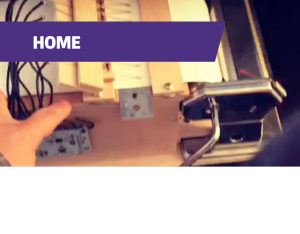Spiro Inquiry
AFTER-SCHOOL EDUCATOR GUIDE
In the Spiro Inquiry, participants learn art and math through physical spiro designs and a digital app. The activities are a low-barrier entry point for youth to explore ideas in art, math, and digital fabrication. Learners move between the physical and digital worlds of design as they play with and create “spiro” patterns with both physical gears and pens and with the free Spirogator app.
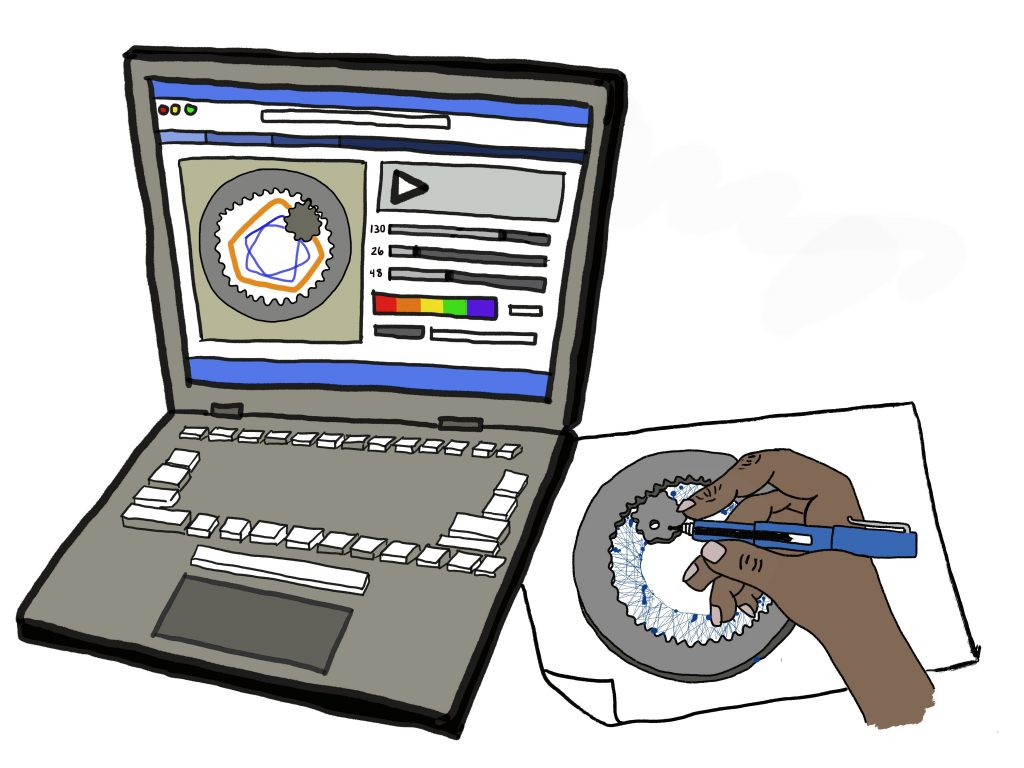
The guide asks participants to collaboratively develop and investigate questions. By enabling learners to determine their own creative goals, this inquiry can help participants learn not only academic math content, but also help them develop new ideas of what math looks like and what it is used for. In this inquiry, mathematical phenomena are among the materials that learners use to explore the aesthetic possibilities of their designs. Participants can also fabricate their drawings and digital files into stickers, prints, stencils or new custom gears, made to their specifications. These activities can be a possible model for designing other equitable, transdisciplinary learning.
Materials & Tools


Getting Started
Our team members have used several different approaches to introduce the Spiro Inquiry:
Paula Hooper leads Spiro Inquiries with both children in after-school settings as well as in professional learning settings for pre-service and in-service educators.
As a teacher educator, she uses the Spiro Inquiry to help teachers develop strong understandings of the power of inquiry-based learning with digital design fabrication.
With youth, she begins workshops with everyone in a circle. She passes the physical gears around so that students can hold them in their hands. She asks if it reminds them of anything? Students have related the gears to things like bicycle gears or the launching mechanisms for spinning tops. Connecting students with what they already know can be especially important for children who experience gendered or racialized stereotypes about who is good at math in math classrooms. (See Theory Corner at the end of this guide.)
Walter Kitundu, multimedia artist and educator, introduces the inquiry to elementary-age youth by talking through the process of learning to use the physical gears. He starts with a demonstration because he has seen that young children are sometimes overwhelmed by the frustration of learning to keep the gears from slipping.
Walter demonstrated how to use gears while saying, “The internal gears are small and they all have little teeth on the outside and those teeth will lock into the teeth on the outside gear. Now I’ll try to get this to run along the edge so the teeth all stay together. But I’m gonna try and do that with my pen. I’m not trying to draw a shape, I’m just trying to keep the gears rolling smoothly together. And because of the way the gears are, it ends up being a really nice image.”
Fan Kong facilitates lifelong learning programs in Chinatown, NYC for youth and senior citizens. She likes to begin by reminding students to slow down and to let the pen follow the movement of the gear, as if we are “listening to the objects speak,” she says. “When we let the objects themselves do the work, their regular pattern and rhythm feels like a form of meditation.” This is especially helpful for young children and elders, who are learning (or re-learning, like with elders with arthritis) the dexterity of their hands, while coordinating their hands and eyes. When learners find their rhythm with this process, they see the designs emerge, revealing themselves as participants move their hands with the gears.
Two Ways to Play: Physical and Digital
Especially when working with young students, we like to start with pen and paper first and then move on to the app so that students begin with a sense of familiarity and experience. Regardless of whether students play with physical gears or the digital app first, their questions and interests will likely extend into the other dimension of spiro play.
Physical Spiro Exploration
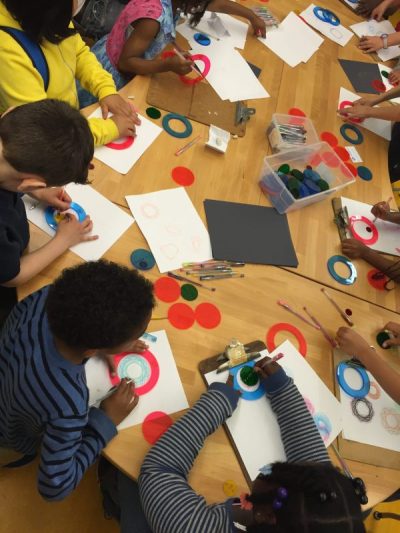
Working with physical spiro gears involves an engagement with dexterity and coordination with our hands, the table, and different moving parts.
Set Up: First, find a way to fix the outer gear on the paper so that only the inner gear moves freely. Clipboards are the easiest solution we’ve tried but limits where the gear can be placed on the paper. You can also use a small amount of mounting putty so that the gear can be placed anywhere on the paper.
In the beginning, it is usually a bit of a challenge to find the rhythm and ease of the amount of outward pressure needed for the gears to stay interlocked. To ease the frustration students might feel when their pen slips, treat this as important intellectual work. Encourage them to think of the first drawings as drafts or experiments.
Facilitator questions to deepen inquiry and extend exploration:
Initial explorations with physical gears is a time for students to notice how combinations of gears with different numbers of teeth and different pen holes change the designs. We have seen students become equally interested in the look of the designs and/or figuring out what the numbers mean for what kinds of designs are made. These are some of the questions we’ve used to deepen inquiry and support all ranges of interests students have while first using Spiro gears:
- What do you notice and what do you wonder about the designs you’re making?
- Tell me about how you made this one and what you like about it?
- What ideas do you want to try next? How do you think we can do that?
- Look at someone else’s drawings. How are they different from yours? How could you made a similar one?
- What do you notice about the numbers of the gears and the shapes of the designs?
- What if your friend wanted to make a design like yours? What would you tell them so they know how to do it?
Digital Spiro Exploration
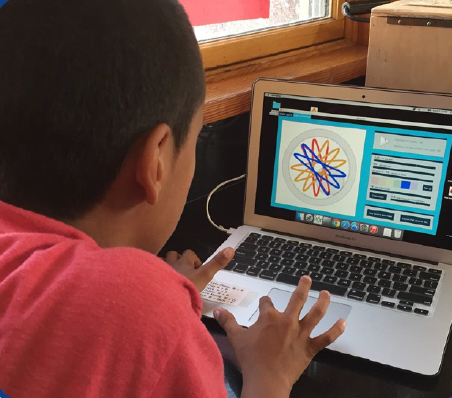
Setting up: We find that a brief introduction to the app and how to use it to make spiro designs is helpful to ensure that all learners start with a sense of familiarity. We generally do not explain every aspect of the app. This allows students to find the use and significance of those features on their own, or together with peers and facilitators. Students often use those features in ways we wouldn’t have anticipated or instructed them to.
The Spirogator App is available in either a web-based or desktop version, both linked here.
Web-based Spirogator App Features:
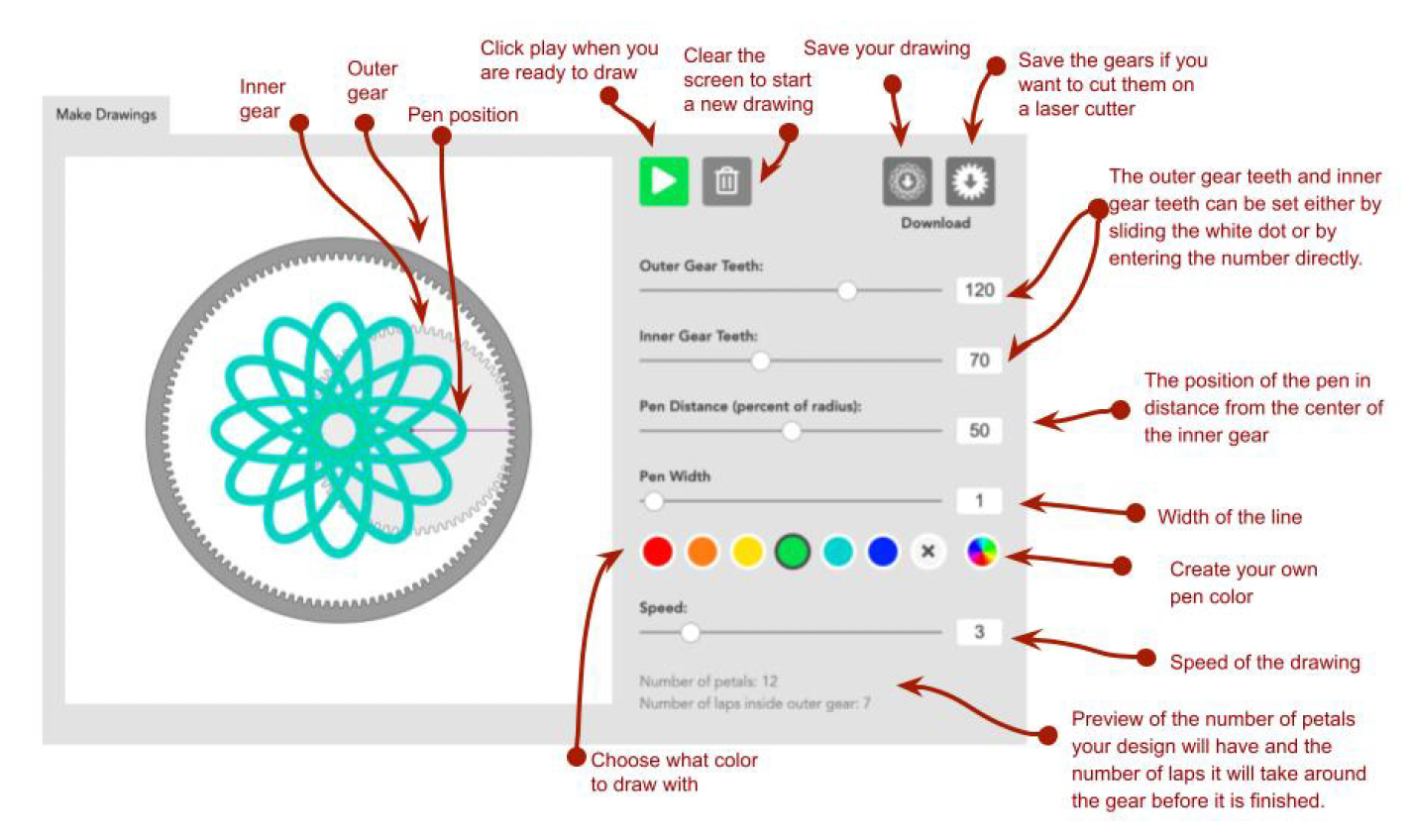
Move Between Physical and Digital Explorations
Ideally, Spiro is an exploration of both the physical and digital modes of creating interesting designs. Experiences in both the digital and physical modes make it possible for learners to see relationships between the drawing of the designs that can not come from only working in one mode. For example, using physical gears, learners may notice the number of loops that are drawn through physically rotating the inner gear and feeling the turns that cause the loops to emerge. When using the digital app to make Spiro designs, they may investigate how many loops will be created with a certain number of gear teeth. They may notice that the number of loops that are created in the app design can be a lot more intricate than the physical designs but the designs are made in the same way. This embodied sense-making invites participants to work across mediums and find multiple pathways into the exploration of phenomenon.
General Questions after some Investigation
One opportunity for learning with Spiro Inquiry is for participants to generate their own questions, which serve as guides to help them deepen their understanding or investigation. Some educators choose to make question generation more explicit by asking students to write their questions to be easily shared with the group. Then, these questions become available for all learners to focus on a second wave of Spiro investigation (see “Try This,” below). Others may choose to informally support question-generation in one-on-one conversations while working with children (see “Facilitator Questions to Spark Inquiry and Exploration,” above). When educators support kids in collectively answering questions about Spiro, they have the opportunity to identify math within students’ creations. In other words, the process of creating a meaningful design/object engages learners in the possibilities between art and math, and between school learning and everyday wondering.
Try this:



After students have some time to play with the gears or the app, ask them to voice or write their questions about what they are noticing. After generating questions, ask students to write their favorite question on a sentence strip or piece of paper and put it up on the wall. Invite students to choose a question that is not their own and investigate that question during a second round of exploration. This approach works well in more structured settings like classrooms.
Where is the Math?
In our own teaching, we don’t start with presenting the math theory when introducing the Spiro Inquiry activity to students. We find that letting students explore their ideas within the playground of complex math can be a more creative and generative experience. However, it’s helpful to have these explanations available if and when students or educators become curious. In this page we offer three explanations that help us understand the math below the surface of spirographs.
Good Problems
The gears slip and mess up the drawing
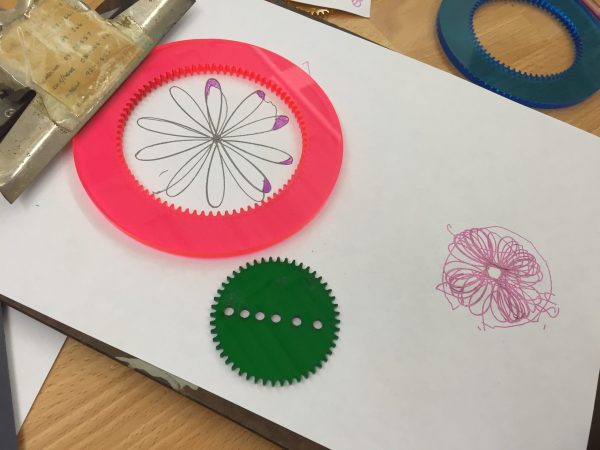
It’s easy for the gear teeth to slip and cause the pen to make errant marks. This can be a cause for frustration. Facilitators can take this as an opportunity to draw attention to the teeth of the gears and the pressure and coordination they need from their hands in order to move smoothly together. A focus on coordination allows participants to become more aware of how they position their bodies while they work. This allows them to slow down and pay attention to their breathing as they steady their hands. Once youth gain fluency with how the gears physically move together, they might use those skills in novel ways.
What if kids are interested in the designs but not the numbers?
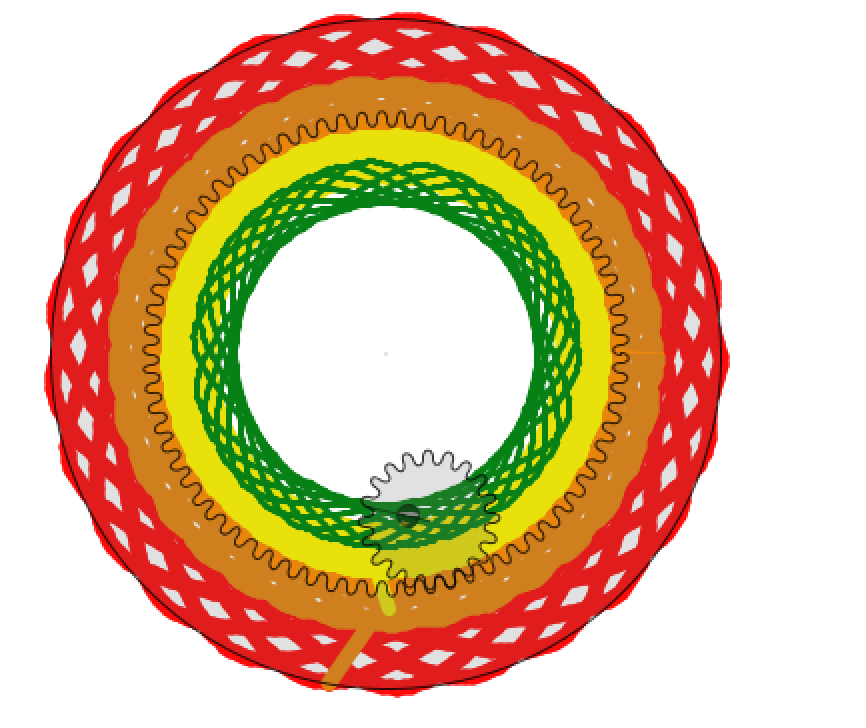
Even when a person is primarily driven by an aesthetic interest in Spiro, the methods and process they are working with is made up of math “material.” Likewise, others who are more driven by engaging specific math questions will find that their investigations result in artful patterns that are intrinsically tied to the math. As facilitators, we keep this in mind when observing what students are interested in, knowing that authentic questions that drive learning are not always ones that sound explicitly mathy. Instead, when engaging in art making, participants often find themselves asking implicit questions of tools and materials. For example, one student was observed trying to make a rainbow spiro design. To achieve this, the student had to figure out how to change the parameters so the design got smaller and smaller without overlapping colors. For each color to follow without interruption, they lined up the teeth of the gears to where the last drawing ended before starting the drawing. In this example, like so many others, an aesthetic goal inspired technical expertise.
Is it okay to use the app this way?

Sometimes learners become interested in pushing the boundaries of the app. “Glitching” the app can be a wonderful exploration of the possibilities of the digital realm. Some of the explorations we have seen learners explore involve making the number of teeth on the inside gear larger than the number of teeth on the outside gear. Sometimes learners will try moving the sliders while the app is drawing. This can open up “what if” conversations about what is possible when we are not constrained by the laws of physics, like “What if we could draw through plastic?”
Less interest in the digital mode
It might seem like kids are exclusively focused on either the physical or the digital and are hesitant to move between them. This presents an opportunity to observe and talk with the student to understand which unique options their preferred mode is offering them. For example, some children prefer to create designs on paper because they are able to use metallic colored pens on colorful paper—an aesthetic that isn’t possible with the digital app. Although moving from physical to digital is one possible pathway for this activity, explorations can take many paths. Not all technologies are digital: the potentials for learning and exploration are not superior in the digital space, just different.
PRINTING & FABRICATION
Moving work off individual computer screens and into the physical world gives it new life to be learned from, shared and built upon.
Make Color Prints:
Some of the more intricate and colorful designs young people make on the app make for beautiful prints. We have often brought small, portable inkjet printers to afterschool workshops so that children can share their creations with friends, family and each other. Moving work off individual computer screens and into the physical workshop space gives it new, communal life to be learned from, appreciated and built upon. We once constructed a string of prints and hung them in the afterschool center like papel picado or paper flags. Here are some examples made by our students that make great prints:
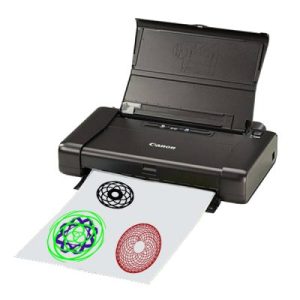

Cut Stickers, Iron-on Patches, Stencils, etc:
Using the craft cutter to cut Spiro designs is another great way to bring the digital designs into physical form. Simpler designs with thick lines make great stickers or stencils. Designing with this purpose in mind can be an excellent opportunity for students to design intentionally using the knowledge they have developed around what kind of parameters would be easy for the craft cutter to cut. Below are examples of designs our student have made into stickers:
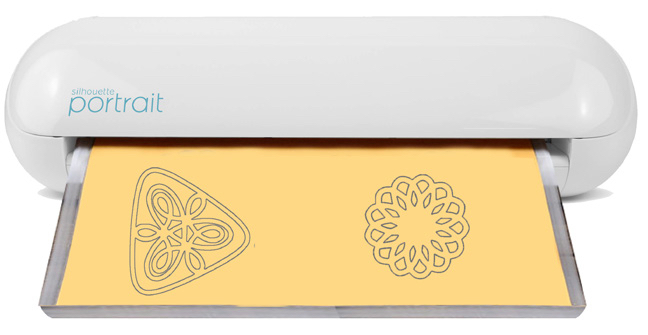

TIPS for cutting spiro stickers or stencils in the craft cutter:
- Use dark colors like black or blue which will be easily traced in the craft cutter software.
- Export your design and save the file where you’ll be able to find it
- Open the file in your craft cutter’s software and use the trace function to create a cut line.
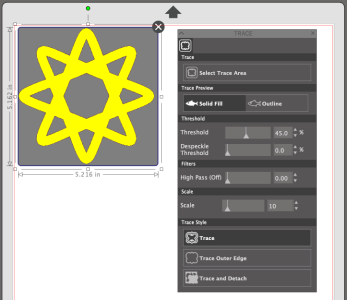
Designing for a Laser Cutter:
If you have access to a laser cutter, the same principles for making stickers apply when cutting or etching into other materials like wood:
Cut your own physical gears
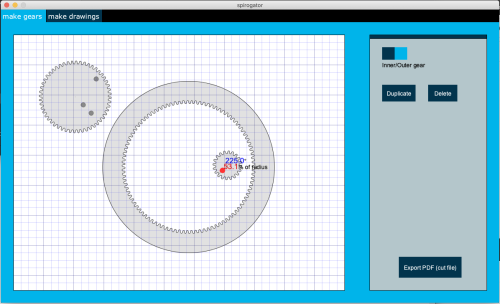
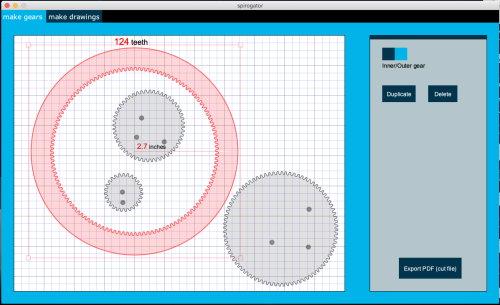
The Spirogator apps allow you to design and cut your own gears to be used in workshops or for students to take home. We recommend 1/4” plexi for outer gears and 1/4” or 1/8” for inner gears.
The desktop version of the app generates a vector based pdf file to be cut with your laser cutter’s software. The web version of Spirogator generates an svg file also readable by your laser cutter’s software.
Both versions as well as premade cut files are available on the resources page.
We invite you to think with this section about how Spiro is designed and why it can be a good tool for learning and making. You might also use the ideas and designs behind Spiro Inquiry to create other learning activities.
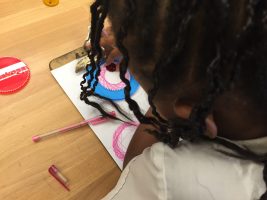
Constructionism as a theory and a design principle: Spiro as a good tool for learning, play, exploration, and making
One way to understand why Spiro can be used to support learning in informal making spaces is through a lens of constructionist theory (Papert, 1993). Spiro Inquiry embodies the constructionist theory of learning, which argues that learning through the creation of projects is a particularly good way for learners to form new ideas (Hooper & Freed, 2013). Seymour Papert’s experiences playing and building with gears as a child helped form his understanding of learning as a connection between sense making with physical tools and the formation of math concepts such as gear ratios (Papert, 1980).
Constructionism is both a theory of learning and a principle for designing learning environments. As a theory of learning, constructionism explains that through play with making spiro shapes, learners form their own mathematical ideas by making sense of the patterns within their designs. As a design principle, constructionism uses computational ideas as tools for learning math through making and play. For example, in Spiro the process of working with physical and digital tools helps learners to create their own mathematical ideas as they make their designs (See section on Where’s the Math? for more on hypotrochoid curves). From a constructionist perspective, it is important for teachers to support learners in forming their own questions and using the tools to further investigate designs that are interesting to them.
Digital and Physical Fluency: The power of tools that relate the physical and digital
Spiro Inquiry has complementary physical and digital tools that offer different ways to create similar representations. This “bi-directional digital and physical fluency” encourages them to use their understanding in one discipline towards growth in another discipline (Eisenberg & Eisenberg, 1999). Important to this practice is how educators choose tools and materials to support young peoples’ inquiries into STEM and computing practices (Blikstein, Kafai & Pea, 2019). In settings where young people have engaged in Spiro Inquiry, their fluid play and construction in physical and digital spaces enabled their math and art inquiries to become intertwined (Vossoughi, Hooper, & Escudé, 2016; Qi & Buechley, 2014; Eisenberg, 2003). Communication, reflection, and iteration among the group allows young people to figure out new ideas both individually and collectively (Hooper & Freed, 2013).
Support for making environments nurture equity and multiple ways of knowing
The exploration, collaboration, and communication that can happen when learners are engaged in Spiro Inquiry are particularly good ways to support equity and inclusion within maker spaces. Spiro Inquiry activities in maker spaces can become an example of how to nurture “cultural ways of knowing intertwined with constructionism” (Hooper, 1998). Specifically, there are three dimensions of equity that educators can use Spiro to support:
1) Counter racialized discourses about who can develop complex mathematical ideas
Learners who create Spiro designs are often working through complex mathematical problems regardless of their levels of achievement or mathematical identities in school. Engaged practices outside of school can provide opportunities for educators to create spaces where young people develop mathematical ideas and practices that counter the racialized discourses that often circulate in math classrooms (Nasir et al., 2008; Shah & Leonardo, 2017). Spiro Inquiry is one such engaged practice that can be used to shape mathematical experiences connected to personal, artistic, and creative endeavors, while subverting racialized discourses about mathematical ability.
2) Shift the goal from finding answers to jointly exploring mathematical phenomena
Spiro Inquiry engages this second dimension of equity by providing mathematical inquiry as a tool for the creation of designs (Hooper & Freed, 2013). This move shifts the goal of learning from finding answers to developing personally meaningful inquiries, thus shifting the goal from finding answers to jointly exploring mathematical phenomena.
3) Center the diverse forms that mathematical thinking can take
Spiro Inquiry supports a third dimension of equity by centering the diverse forms that mathematical thinking can take, especially across a variety of cultural practices. Spiro activities are resonant with other informal math practices that take place in family settings and outside of school. For example, Nasir et al. (2002) examined the domino play of African American young people where they developed complex mathematical strategy through joint problem-solving and traditions of game play rooted in cultural histories of the African diaspora. Like dominoes, Spiro offers opportunities for mathematical inquiry alongside collective joy and creative expression that can be culturally resonant. The way that young people can engage with mathematical practice outside of school can change the paradigm of what it means for young people to be mathematical.
Paula and Natalie created the Spiro activities through years of working together at the Exploratorium and in many other settings. Their work with young people doing Spiro Inquiry allowed them to see the possibilities of teaching and learning with these exciting concepts and tools.

– Dr. Paula K. Hooper, Assistant Professor of Instruction, Northwestern University
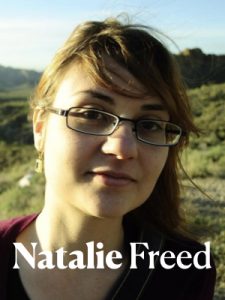
– Natalie Freed, Doctoral Student, University of Texas Austin

HOW IS IT High Tech Low Cost?
We use the term High Tech Low Cost for projects that use “high-tech, low-cost” digital tools while engaging in high-complexity thinking and creating. We believe that cost shouldn’t be a barrier for meaningfully including technology in creative learning.
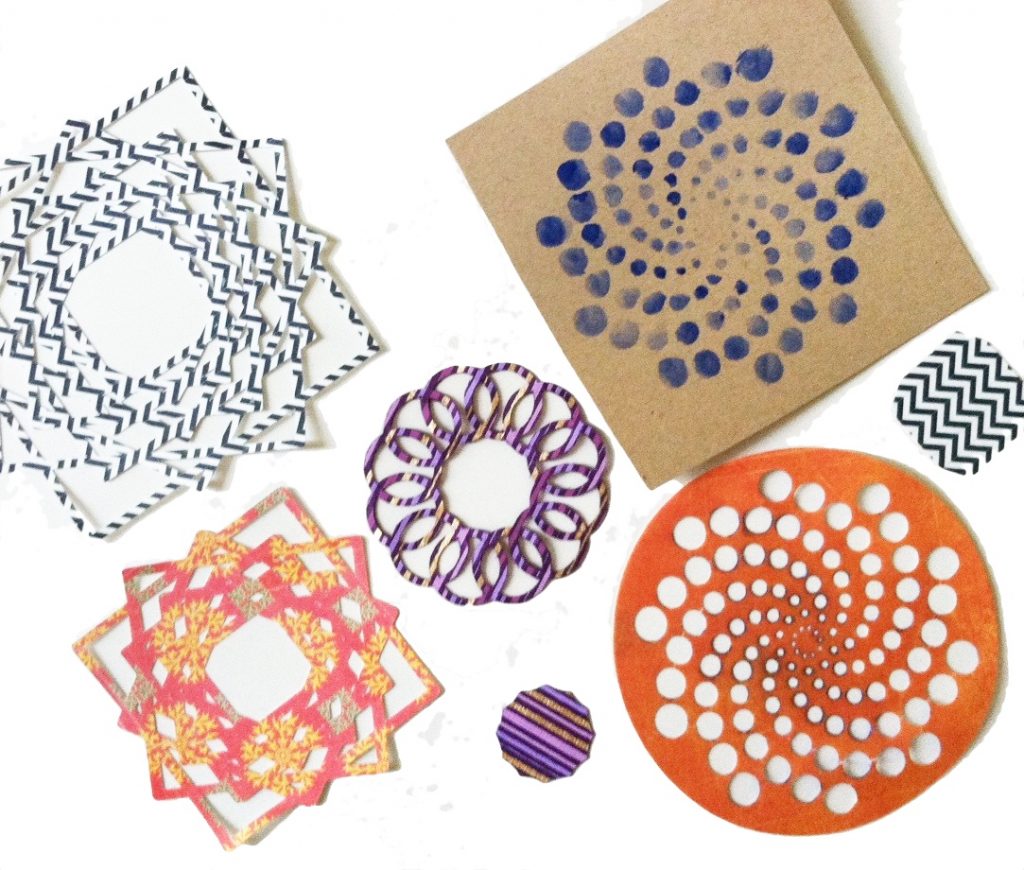
The Spiro Inquiry is an accessible activity where young people can explore artistic and mathematical phenomenon with paper, pens, and a spiro gear set and/or with a computer or phone and access to the internet. In the digital Spirogator app, students can investigate the same questions and designs using an expanded set of parameters to work with that can be more precisely adjusted. The app can also be used with fabrication tools such as a craft cutter, printer, sticker maker, or laser cutter. Our students have turned their designs into stickers, stencils, gift cards and wall hangings. The Spriogator app is FREE and is available here.


Thanks to the generous funding of the National Science Foundation.
